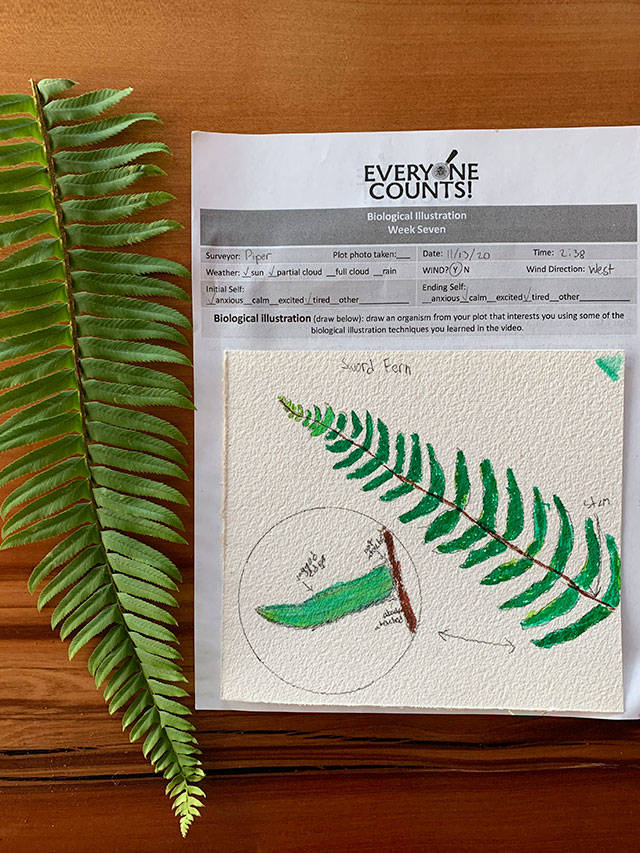By Susan McCabe
For Vashon Island School District
Humans have proven throughout time that adversity motivates creativity, and Vashon Nature Center’s (VNC) Everyone Counts! program is yet another example of the invention a crisis can stimulate.
At the time the pandemic struck, VNC was in the middle of launching a hands-on science project with the schools. So, the organization was ready to spring into action when Vashon Island School District (VISD) School Superintendent Slade McSheehy reached out to local groups and educators in search of ways to support teachers during distance learning.
“We started figuring out how we could pivot to online schooling and still get these kids outside,” said VNC founder and director Bianca Perla.
From that challenge, Everyone Counts was born.
Critical support for the program’s $20,000 budget this year came from the Vashon Schools Foundation, a PIE Scientists in Schools grant, a King County Service Area grant, the Russell Family Foundation and individual donations.
VNC officially launched Everyone Counts on Sept. 24, three weeks into the school year. In the program’s 12 weeks, every session starts with a video prompt to create a theme for the week — when members of the VNC team introduce an idea like “Your Senses are your Superpowers.”
The program offers a grounding exercise, created by guest expert Andra DeVoght — a beginning especially designed for children who spend their days connected to screens in distance learning. Participants use a VNC data sheet customized to that week’s theme to record their observations from the weather, to the wind direction, to their feelings at the start of their 20-minute “sit spot” session and then again at the end.
While the course is self-paced, each weekly theme builds on prior sessions to encourage a deeper connection to nature through sensual observation, moving through discoveries to foster enthusiasm for scientific observation and recording. In one session, for instance, students learn – in English and Spanish — how different species experience sound and how they use it to survive. Another session points out patterns in Nature.
Everyone Counts! is cleverly designed to employ sensual and scientific observation along with varied methods of recording. Coached by VNC Field Guide Adrian Swain, participants draw plots and sound maps to hone their listening skills. with guidance from nature artist Annie Brule, they also draw specific plants they’ve chosen to observe. As students learn about scientific observation, they add notes to their drawings to illustrate their understanding of what they’re seeing.
In other words, the program incorporates art, music, language, math and science in each week’s activities, along with activities to grow self-awareness and emotional well-being.
“It’s a course in nature observation, mindfulness practice and biodiversity concepts – those are the three pillars that Everyone Counts hinges upon,” said Maria Metler, education specialist for VNC. “Those are the ways we found we could address the needs of students, teachers and parents.”
Once they’d designed the program, it was clear to VNC leaders that Everyone Counts! should be made available to, well, everyone. Today’s registration count for the program is more than 800.
Seventeen educators are registered in the Everyone Counts program, each representing approximately 20 students. Perla and Metler say they are pleased with educators’ response to the program because they’re using it as a resource, picking the aspects that resonate with their classes and making it their own.
“This is just what we hoped would happen with the program,” says Perla, adding that VNC welcomes feedback from teachers, homeschoolers and adults.
Everyone Counts doesn’t stop at the shores of Vashon. Midway through the course, participants conduct a biodiversity survey the results of which can be recorded in iNaturalist, a global database that includes Salish Sea discoveries and is sponsored by the California Academy of Sciences out of UC Berkeley.
This is where scientific practice really takes hold in the course — practicing skills such as learning to record each plot’s longitude and latitude. Technology also comes into play when participants use specialized phone apps for photographing and identifying species.
When Everyone Counts started, VNC had recorded 2,054 species from Vashon. As of Nov. 17, the VNC website tally shows 2,150 species of plants, animals, fungi, lichens, mosses and more that have been voluntarily submitted to iNaturalist by program participants. An iNaturalist app called Seek allows instant species identification for the smallest or the most impatient of budding natural scientists.
Perla and Metler describe Everyone Counts as a pilot program.
“No one’s ever done this before,” says Perla. “It pulls together community science for all ages; we say K to 100. It’s bi-lingual with help from Spanish biologist Vale Martinez Espinoza. It pulls together scientific concepts, mindfulness concepts, nature observation and outdoor etiquette all in one place.”
VNC plans a community wrap-up meeting on Dec. 10 to consolidate feedback and incorporate it into the program’s ultimate design. Their plan is to roll the program out to other communities, environmental organizations and schools once they’ve completed and polished the full 12-week course.
In the meantime, Perla, Metler and other members of the VNC team are burning the midnight oil to create high-quality video, audio and written material for the course. To get a taste of Everyone Counts or to join Vashon Nature Center’s growing army of citizen scientists in the program, go to vashonnaturecenter.org/everyone-counts.


